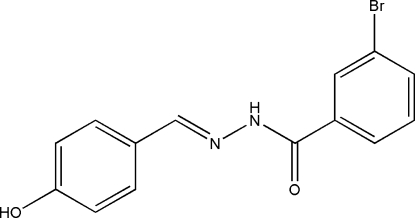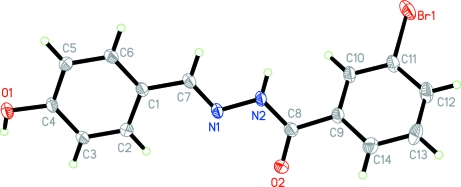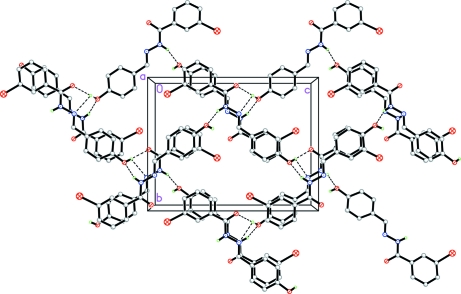Abstract
The title compound, C14H11BrN2O2, was synthesized by the reaction of 4-hydroxybenzaldehyde with an equimolar quantity of 3-bromobenzohydrazide in methanol. The dihedral angle between the two benzene rings is 40.1 (2)°. In the crystal structure, molecules are linked through intermolecular O—H⋯O, O—H⋯N and N—H⋯O hydrogen bonds to form a three-dimensional network.
Related literature
Experimental
Crystal data
C14H11BrN2O2
M r = 319.16
Orthorhombic,

a = 7.5576 (11) Å
b = 11.7337 (18) Å
c = 15.021 (2) Å
V = 1332.0 (3) Å3
Z = 4
Mo Kα radiation
μ = 3.08 mm−1
T = 298 (2) K
0.20 × 0.17 × 0.16 mm
Data collection
Bruker SMART CCD area-detector diffractometer
Absorption correction: multi-scan (SADABS; Bruker, 2001 ▶) T min = 0.577, T max = 0.638
7740 measured reflections
2757 independent reflections
2145 reflections with I > 2σ(I)
R int = 0.038
Refinement
R[F 2 > 2σ(F 2)] = 0.030
wR(F 2) = 0.059
S = 0.97
2757 reflections
176 parameters
1 restraint
H atoms treated by a mixture of independent and constrained refinement
Δρmax = 0.17 e Å−3
Δρmin = −0.29 e Å−3
Absolute structure: Flack (1983 ▶), with 1154 Friedel pairs
Flack parameter: 0.006 (9)
Data collection: SMART (Bruker, 2007 ▶); cell refinement: SAINT (Bruker, 2007 ▶); data reduction: SAINT; program(s) used to solve structure: SHELXTL (Sheldrick, 2008 ▶); program(s) used to refine structure: SHELXTL; molecular graphics: SHELXTL; software used to prepare material for publication: SHELXTL.
Supplementary Material
Crystal structure: contains datablocks global, I. DOI: 10.1107/S1600536808015912/sj2509sup1.cif
Structure factors: contains datablocks I. DOI: 10.1107/S1600536808015912/sj2509Isup2.hkl
Additional supplementary materials: crystallographic information; 3D view; checkCIF report
Table 1. Hydrogen-bond geometry (Å, °).
| D—H⋯A | D—H | H⋯A | D⋯A | D—H⋯A |
|---|---|---|---|---|
| O1—H1⋯O2i | 0.82 | 1.95 | 2.750 (2) | 166 |
| O1—H1⋯N1i | 0.82 | 2.56 | 3.003 (3) | 116 |
| N2—H2A⋯O1ii | 0.904 (10) | 2.136 (14) | 3.007 (3) | 162 (3) |
Symmetry codes: (i)  ; (ii)
; (ii)  .
.
Acknowledgments
The Natural Scientific Research Foundation of the Education Office of Shanxi Province (Project No. 07JK177) and the Special Scientific Research Foundation of the Education Office of Shanxi Province (Project No. 04JK302) are gratefully acknowledged.
supplementary crystallographic information
Comment
We have recently reported some transition metal complexes with Schiff base ligands (Cao, 2007a,b). We report herein the crystal structure of the title compound, (I), derived from the reaction of 4-hydroxybenzaldehyde with an equimolar quantity of 3-bromobenzohydrazide in methanol.
In compound (I), Fig. 1, the dihedral angle between the two benzene rings is 40.1 (2)°. In the crystal structure, molecules are linked through intermolecular O—H···O, O—H···N, and N—H···O hydrogen bonds, Table 1, to form a three-dimensional network, Figure 2.
Experimental
The compound was prepared by refluxing equimolar quantities of 4-hydroxybenzaldehyde with 3-bromobenzohydrazide in methanol. Colourless block-like crystals were formed when the solution was evaporated in air for about a week.
Refinement
H2A was located in a difference Fourier map and refined isotropically, with the N—H distance restrained to 0.90 (1) Å. The other H atoms were placed in idealized positions and constrained to ride on their parent atoms, with C—H distances of 0.93 Å, the O—H distance 0.82 Å, and with Uiso(H) set at 1.2Ueq(C) and 1.5Ueq(O).
Figures
Fig. 1.
The molecular structure of (I) with ellipsoids drawn at the 30% probability level.
Fig. 2.
The molecular packing of (I), viewed along the a axis. Hydrogen bonds are drawn as dashed lines.
Crystal data
| C14H11BrN2O2 | F000 = 640 |
| Mr = 319.16 | Dx = 1.591 Mg m−3 |
| Orthorhombic, P212121 | Mo Kα radiation λ = 0.71073 Å |
| Hall symbol: P 2ac 2ab | Cell parameters from 1827 reflections |
| a = 7.5576 (11) Å | θ = 2.3–24.5º |
| b = 11.7337 (18) Å | µ = 3.09 mm−1 |
| c = 15.021 (2) Å | T = 298 (2) K |
| V = 1332.0 (3) Å3 | Block, colourless |
| Z = 4 | 0.20 × 0.17 × 0.16 mm |
Data collection
| Bruker SMART CCD area-detector diffractometer | 2757 independent reflections |
| Radiation source: fine-focus sealed tube | 2145 reflections with I > 2σ(I) |
| Monochromator: graphite | Rint = 0.038 |
| T = 298(2) K | θmax = 26.6º |
| ω scans | θmin = 2.2º |
| Absorption correction: multi-scan(SADABS; Bruker, 2001) | h = −9→9 |
| Tmin = 0.577, Tmax = 0.638 | k = −10→14 |
| 7740 measured reflections | l = −18→18 |
Refinement
| Refinement on F2 | Hydrogen site location: inferred from neighbouring sites |
| Least-squares matrix: full | H atoms treated by a mixture of independent and constrained refinement |
| R[F2 > 2σ(F2)] = 0.031 | w = 1/[σ2(Fo2) + (0.0151P)2] where P = (Fo2 + 2Fc2)/3 |
| wR(F2) = 0.059 | (Δ/σ)max = 0.001 |
| S = 0.97 | Δρmax = 0.17 e Å−3 |
| 2757 reflections | Δρmin = −0.29 e Å−3 |
| 176 parameters | Extinction correction: none |
| 1 restraint | Absolute structure: Flack (1983), with 1154 Friedel pairs |
| Primary atom site location: structure-invariant direct methods | Flack parameter: 0.006 (9) |
| Secondary atom site location: difference Fourier map |
Special details
| Geometry. All e.s.d.'s (except the e.s.d. in the dihedral angle between two l.s. planes) are estimated using the full covariance matrix. The cell e.s.d.'s are taken into account individually in the estimation of e.s.d.'s in distances, angles and torsion angles; correlations between e.s.d.'s in cell parameters are only used when they are defined by crystal symmetry. An approximate (isotropic) treatment of cell e.s.d.'s is used for estimating e.s.d.'s involving l.s. planes. |
| Refinement. Refinement of F2 against ALL reflections. The weighted R-factor wR and goodness of fit S are based on F2, conventional R-factors R are based on F, with F set to zero for negative F2. The threshold expression of F2 > σ(F2) is used only for calculating R-factors(gt) etc. and is not relevant to the choice of reflections for refinement. R-factors based on F2 are statistically about twice as large as those based on F, and R- factors based on ALL data will be even larger. |
Fractional atomic coordinates and isotropic or equivalent isotropic displacement parameters (Å2)
| x | y | z | Uiso*/Ueq | ||
| Br1 | 0.04594 (5) | 0.39161 (3) | 0.901456 (17) | 0.06805 (13) | |
| O1 | 0.1347 (3) | −0.14174 (14) | 0.15827 (10) | 0.0414 (5) | |
| H1 | 0.0663 | −0.1163 | 0.1208 | 0.062* | |
| O2 | 0.0446 (3) | 0.45672 (13) | 0.48129 (10) | 0.0435 (4) | |
| N1 | 0.1134 (3) | 0.23480 (18) | 0.46451 (12) | 0.0380 (6) | |
| N2 | 0.1329 (3) | 0.29110 (18) | 0.54514 (12) | 0.0372 (5) | |
| C1 | 0.1401 (3) | 0.0602 (2) | 0.38450 (14) | 0.0310 (6) | |
| C2 | 0.0757 (3) | 0.1044 (2) | 0.30437 (14) | 0.0343 (6) | |
| H2 | 0.0339 | 0.1789 | 0.3024 | 0.041* | |
| C3 | 0.0735 (3) | 0.03889 (19) | 0.22853 (14) | 0.0331 (6) | |
| H3 | 0.0315 | 0.0692 | 0.1754 | 0.040* | |
| C4 | 0.1341 (3) | −0.0726 (2) | 0.23148 (14) | 0.0309 (6) | |
| C5 | 0.1975 (3) | −0.1177 (2) | 0.31015 (15) | 0.0357 (6) | |
| H5 | 0.2381 | −0.1925 | 0.3120 | 0.043* | |
| C6 | 0.2003 (3) | −0.0514 (2) | 0.38585 (15) | 0.0352 (6) | |
| H6 | 0.2432 | −0.0820 | 0.4387 | 0.042* | |
| C7 | 0.1494 (3) | 0.1299 (2) | 0.46504 (15) | 0.0348 (6) | |
| H7 | 0.1829 | 0.0958 | 0.5183 | 0.042* | |
| C8 | 0.0976 (3) | 0.4039 (2) | 0.54681 (14) | 0.0339 (6) | |
| C9 | 0.1227 (3) | 0.4615 (2) | 0.63473 (15) | 0.0333 (6) | |
| C10 | 0.0837 (3) | 0.4069 (2) | 0.71421 (14) | 0.0373 (6) | |
| H10 | 0.0457 | 0.3315 | 0.7143 | 0.045* | |
| C11 | 0.1020 (4) | 0.4657 (2) | 0.79290 (15) | 0.0405 (7) | |
| C12 | 0.1571 (4) | 0.5781 (2) | 0.79396 (18) | 0.0482 (8) | |
| H12 | 0.1689 | 0.6169 | 0.8476 | 0.058* | |
| C13 | 0.1942 (4) | 0.6314 (2) | 0.7149 (2) | 0.0516 (8) | |
| H13 | 0.2320 | 0.7068 | 0.7151 | 0.062* | |
| C14 | 0.1760 (4) | 0.5743 (2) | 0.63504 (17) | 0.0425 (7) | |
| H14 | 0.1995 | 0.6116 | 0.5817 | 0.051* | |
| H2A | 0.195 (4) | 0.257 (2) | 0.5890 (15) | 0.080* |
Atomic displacement parameters (Å2)
| U11 | U22 | U33 | U12 | U13 | U23 | |
| Br1 | 0.0960 (3) | 0.0793 (2) | 0.02888 (14) | 0.0102 (2) | 0.00631 (17) | −0.00726 (16) |
| O1 | 0.0589 (13) | 0.0376 (10) | 0.0276 (8) | 0.0034 (9) | −0.0034 (9) | −0.0093 (8) |
| O2 | 0.0655 (12) | 0.0350 (10) | 0.0301 (8) | 0.0023 (10) | −0.0072 (10) | 0.0018 (8) |
| N1 | 0.0566 (16) | 0.0338 (13) | 0.0237 (10) | 0.0039 (11) | −0.0060 (10) | −0.0063 (9) |
| N2 | 0.0581 (16) | 0.0306 (13) | 0.0230 (11) | 0.0104 (11) | −0.0077 (10) | −0.0070 (9) |
| C1 | 0.0354 (14) | 0.0340 (13) | 0.0236 (13) | −0.0019 (11) | −0.0012 (10) | −0.0033 (10) |
| C2 | 0.0435 (16) | 0.0295 (12) | 0.0298 (11) | −0.0011 (13) | 0.0013 (11) | −0.0003 (11) |
| C3 | 0.0424 (16) | 0.0334 (14) | 0.0235 (11) | 0.0021 (12) | −0.0035 (11) | 0.0015 (10) |
| C4 | 0.0343 (14) | 0.0348 (15) | 0.0238 (12) | −0.0046 (11) | 0.0011 (11) | −0.0070 (10) |
| C5 | 0.0470 (17) | 0.0258 (14) | 0.0343 (12) | 0.0036 (13) | −0.0010 (11) | −0.0011 (12) |
| C6 | 0.0452 (16) | 0.0362 (14) | 0.0243 (13) | 0.0032 (11) | −0.0068 (11) | 0.0013 (11) |
| C7 | 0.0414 (15) | 0.0393 (17) | 0.0238 (11) | 0.0003 (13) | −0.0026 (11) | −0.0027 (11) |
| C8 | 0.0370 (16) | 0.0361 (15) | 0.0287 (12) | −0.0032 (13) | 0.0000 (10) | −0.0013 (12) |
| C9 | 0.0362 (15) | 0.0342 (15) | 0.0297 (12) | 0.0039 (12) | −0.0045 (11) | −0.0069 (11) |
| C10 | 0.0434 (17) | 0.0381 (14) | 0.0304 (12) | 0.0049 (13) | −0.0038 (11) | −0.0097 (12) |
| C11 | 0.0450 (18) | 0.0456 (17) | 0.0308 (13) | 0.0094 (13) | −0.0012 (11) | −0.0093 (12) |
| C12 | 0.0512 (19) | 0.055 (2) | 0.0388 (15) | 0.0096 (15) | −0.0131 (14) | −0.0196 (14) |
| C13 | 0.054 (2) | 0.0368 (17) | 0.0644 (19) | 0.0002 (14) | −0.0103 (15) | −0.0221 (15) |
| C14 | 0.0483 (18) | 0.0370 (17) | 0.0421 (15) | −0.0020 (13) | −0.0031 (13) | −0.0037 (12) |
Geometric parameters (Å, °)
| Br1—C11 | 1.896 (3) | C5—C6 | 1.378 (3) |
| O1—C4 | 1.367 (3) | C5—H5 | 0.9300 |
| O1—H1 | 0.8200 | C6—H6 | 0.9300 |
| O2—C8 | 1.230 (3) | C7—H7 | 0.9300 |
| N1—C7 | 1.260 (3) | C8—C9 | 1.495 (3) |
| N1—N2 | 1.387 (2) | C9—C14 | 1.384 (4) |
| N2—C8 | 1.351 (3) | C9—C10 | 1.387 (3) |
| N2—H2A | 0.904 (10) | C10—C11 | 1.376 (3) |
| C1—C6 | 1.386 (3) | C10—H10 | 0.9300 |
| C1—C2 | 1.398 (3) | C11—C12 | 1.382 (4) |
| C1—C7 | 1.462 (3) | C12—C13 | 1.371 (4) |
| C2—C3 | 1.374 (3) | C12—H12 | 0.9300 |
| C2—H2 | 0.9300 | C13—C14 | 1.381 (4) |
| C3—C4 | 1.386 (3) | C13—H13 | 0.9300 |
| C3—H3 | 0.9300 | C14—H14 | 0.9300 |
| C4—C5 | 1.381 (3) | ||
| C4—O1—H1 | 109.5 | N1—C7—H7 | 119.0 |
| C7—N1—N2 | 115.88 (19) | C1—C7—H7 | 119.0 |
| C8—N2—N1 | 117.51 (19) | O2—C8—N2 | 122.9 (2) |
| C8—N2—H2A | 121.7 (19) | O2—C8—C9 | 121.4 (2) |
| N1—N2—H2A | 119 (2) | N2—C8—C9 | 115.7 (2) |
| C6—C1—C2 | 118.5 (2) | C14—C9—C10 | 120.1 (2) |
| C6—C1—C7 | 120.0 (2) | C14—C9—C8 | 118.2 (2) |
| C2—C1—C7 | 121.4 (2) | C10—C9—C8 | 121.7 (2) |
| C3—C2—C1 | 120.7 (2) | C11—C10—C9 | 119.1 (2) |
| C3—C2—H2 | 119.7 | C11—C10—H10 | 120.5 |
| C1—C2—H2 | 119.7 | C9—C10—H10 | 120.5 |
| C2—C3—C4 | 119.8 (2) | C10—C11—C12 | 121.3 (2) |
| C2—C3—H3 | 120.1 | C10—C11—Br1 | 119.1 (2) |
| C4—C3—H3 | 120.1 | C12—C11—Br1 | 119.65 (19) |
| O1—C4—C5 | 117.4 (2) | C13—C12—C11 | 119.1 (2) |
| O1—C4—C3 | 122.4 (2) | C13—C12—H12 | 120.4 |
| C5—C4—C3 | 120.2 (2) | C11—C12—H12 | 120.4 |
| C6—C5—C4 | 119.7 (2) | C12—C13—C14 | 120.7 (3) |
| C6—C5—H5 | 120.2 | C12—C13—H13 | 119.6 |
| C4—C5—H5 | 120.2 | C14—C13—H13 | 119.6 |
| C5—C6—C1 | 121.1 (2) | C13—C14—C9 | 119.7 (3) |
| C5—C6—H6 | 119.5 | C13—C14—H14 | 120.1 |
| C1—C6—H6 | 119.5 | C9—C14—H14 | 120.1 |
| N1—C7—C1 | 122.1 (2) |
Hydrogen-bond geometry (Å, °)
| D—H···A | D—H | H···A | D···A | D—H···A |
| O1—H1···O2i | 0.82 | 1.95 | 2.750 (2) | 166 |
| O1—H1···N1i | 0.82 | 2.56 | 3.003 (3) | 116 |
| N2—H2A···O1ii | 0.904 (10) | 2.136 (14) | 3.007 (3) | 162 (3) |
Symmetry codes: (i) −x, y−1/2, −z+1/2; (ii) −x+1/2, −y, z+1/2.
Footnotes
Supplementary data and figures for this paper are available from the IUCr electronic archives (Reference: SJ2509).
References
- Bruker (2001). SADABS Bruker AXS Inc., Madison, Wisconsin, USA.
- Bruker (2007). SMART and SAINT Bruker AXS Inc., Madison, Wisconsin, USA.
- Cao, G.-B. (2007a). Synth. React. Inorg. Met.-Org. Nano-Met. Chem.37, 639–642.
- Cao, G.-B. (2007b). Acta Cryst. E63, m1149–m1150.
- Flack, H. D. (1983). Acta Cryst. A39, 876–881.
- Sheldrick, G. M. (2008). Acta Cryst. A64, 112–122. [DOI] [PubMed]
Associated Data
This section collects any data citations, data availability statements, or supplementary materials included in this article.
Supplementary Materials
Crystal structure: contains datablocks global, I. DOI: 10.1107/S1600536808015912/sj2509sup1.cif
Structure factors: contains datablocks I. DOI: 10.1107/S1600536808015912/sj2509Isup2.hkl
Additional supplementary materials: crystallographic information; 3D view; checkCIF report





